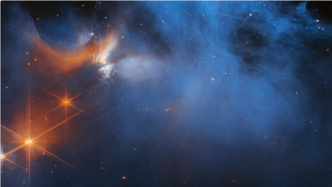
NASA announced today that the James Webb Space Telescope has revealed surprising molecules hidden in icy clouds in the cold, dark universe. These molecules are not ordinary, but a kind of "interstellar brick" that may one day fuse into the next generation of stars or planets, and may even lead to the birth of life as we currently understand it. Related research was published in the recent "Nature" magazine.

This image from the Webb Telescope's near-infrared camera depicts the central region of the Chamaeleon I molecular cloud. NASA/ESA/Canadian Space Agency image
The molecular cloud known as Chamaeleon I is in a mysterious and hazy cosmic space. This star-forming region lies hundreds of light-years from Earth and is thought to be one of the coldest, darkest regions known to man.
Targeting the Chamaeleon I molecular cloud, the Webb Space Telescope detected evidence of a "prebiotic molecule" in the cloud, in addition to finding structures such as frozen carbon dioxide, ammonia, and water Specific chemicals that create the right conditions for the body.
NASA has identified its complex organic molecules and found traces of widespread organic substances such as methanol and ethanol, suggesting that in this molecular cloud, many stars and planetary systems will "inherit" their chemical molecules as they grow. This also means that the presence of "prebiotic molecules" in a star and planetary system should be a common result rather than a unique feature of the solar system. In other words, microbes, plants, and all living things, including humans, on Earth are not that special because the ingredients that make them are actually a common by-product of the growth of stars.
Without Webb, the project scientists said, they simply would not have been able to observe these molecules. Because in such a cold, dense region, most light from background stars is blocked, but Webb's sensitivity is very good at detecting starlight and identifying ice in molecular clouds.
The research may mean that humans are not alone in the universe. But the team emphasizes that this does not mean that alien life has been found, because scientists are not entirely sure what will happen to these "prebiotic molecules" over time. For now, it just opens the door to the search for alien life. new windows.
(Originally titled "Webb Telescope New Discovery Hints Humans Are Not Alone?")
